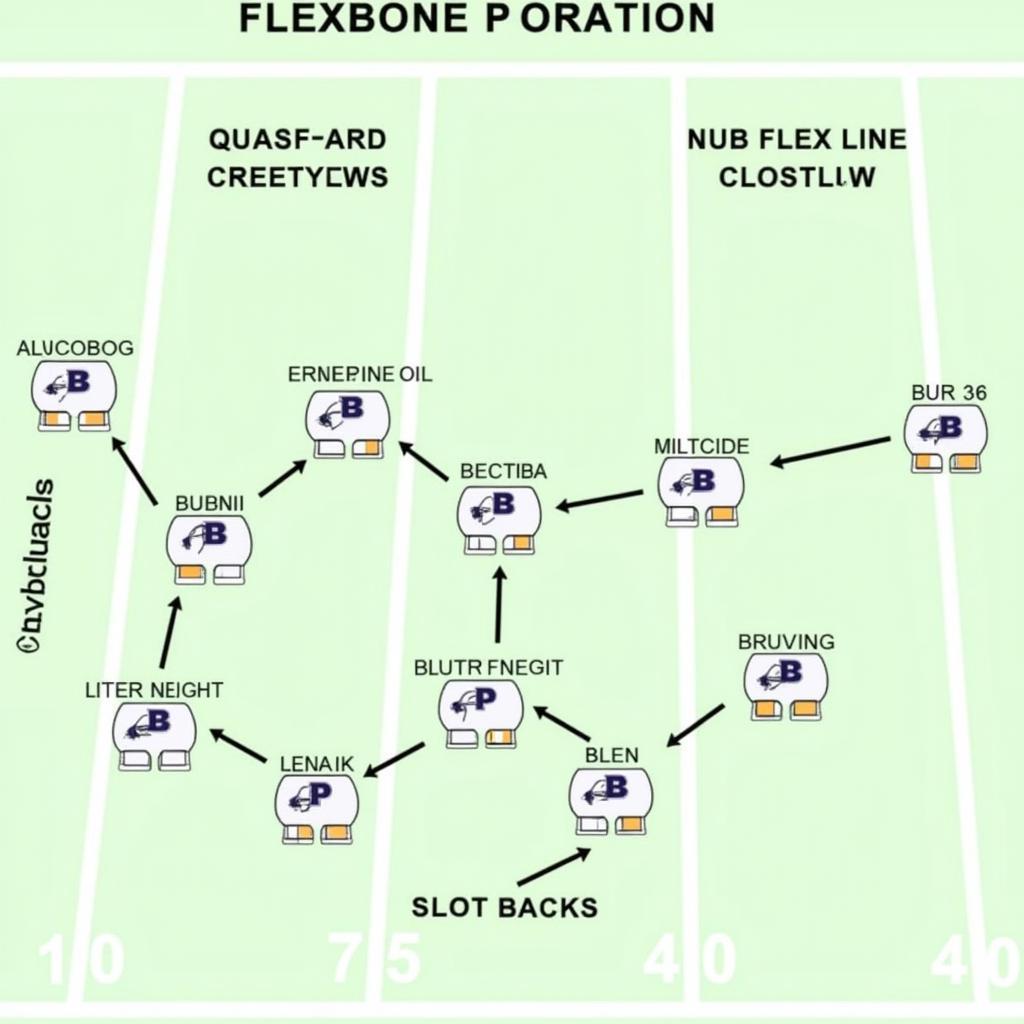Mastering the Flexbone Offense Plays
October 26, 2024The flexbone offense is a dynamic and exciting offensive strategy in American football known for its unique formations and deceptive plays. This system relies heavily on Flexbone Offense Plays, which are designed to confuse the defense and create opportunities for big gains. Let’s dive into the intricacies of this potent offensive scheme.
 Flexbone Formation
Flexbone Formation
Unpacking the Flexbone Formation
The flexbone formation is characterized by its unusual alignment of players. Instead of lining up directly behind the quarterback, the running backs, often referred to as the “A-back” and “B-back,” are positioned offset and slightly behind the quarterback. Additionally, two slotbacks, known as “slotbacks,” are positioned wider than typical receivers. This unique positioning allows for a variety of misdirection plays and option runs.
One of the key advantages of the flexbone formation is its ability to force defenses to defend the entire field. With multiple potential ball carriers, the defense cannot solely focus on the quarterback or a single running back. This element of surprise is central to the effectiveness of flexbone offense plays.
Dissecting Key Flexbone Offense Plays
The Triple Option
The cornerstone of the flexbone offense plays is the triple option. This play begins with the quarterback receiving the snap. The quarterback then has three options:
- Handoff to the B-back: This is the most common option if the defense collapses on the inside run.
- Pitch to the A-back: If the defensive end crashes down on the quarterback, the quarterback can pitch the ball to the A-back who is running wide.
- Keep the Ball: The quarterback can keep the ball and run himself if the defense overcommits to the other options.
The triple option’s effectiveness lies in its ability to react to the defense. The quarterback reads the defensive keys and makes a split-second decision on which option to take. This dynamic play keeps defenses guessing and can lead to explosive plays.
The Midline Option
Another staple of the flexbone offense plays is the midline option. This play is similar to the triple option but instead of the B-back running inside, they run directly at the defensive tackle or nose guard. This forces the defensive lineman to make a decision, either commit to the B-back or stay with the quarterback. If the defensive lineman commits to the B-back, the quarterback can keep the ball and run for a potential big gain.
Counter and Deception
Flexbone offense plays often incorporate counter plays and deception to keep defenses off balance. For instance, the rocket toss sweep appears similar to the triple option initially but features a quick toss to the A-back who then has the option to run or pass the ball. This element of surprise can catch defenses off guard and lead to significant yardage.
The Power of the Flexbone Offense
When executed effectively, flexbone offense plays can be extremely difficult to defend. The combination of misdirection, option runs, and the constant threat of a big play keeps defenses on their toes. Teams that run the flexbone offense well often control the clock, wear down opposing defenses, and dictate the pace of the game.
For fans of exciting and unpredictable offensive football, flexbone offense plays offer a refreshing change of pace from traditional pro-style offenses. It’s a system that requires discipline, precision, and a deep understanding of defensive tendencies. When all the pieces come together, the flexbone offense can be a thing of beauty, leaving defenses bewildered and fans on the edge of their seats.
FAQs about Flexbone Offense Plays
1. What makes the flexbone offense different from other offenses?
The flexbone offense distinguishes itself through its unique formation, with running backs offset and slotbacks positioned wider than usual. This formation, combined with option plays, creates misdirection and forces defenses to cover the entire field.
2. Is the flexbone offense effective at all levels of football?
While commonly associated with high school and college football, the flexbone’s effectiveness depends on the talent and execution of the players. When implemented correctly, it can be successful at any level.
3. What are the disadvantages of the flexbone offense?
The flexbone offense requires specific personnel and may not be suitable for teams lacking athletic quarterbacks or mobile offensive linemen. Additionally, it can be challenging to master and requires a high level of coordination and execution.
4. Can you provide an example of a team that successfully uses the flexbone offense?
The Georgia Tech Yellow Jackets, under coach Paul Johnson, were renowned for their effective use of the flexbone offense. Their success demonstrated the potency of this system against high-level competition.
5. Where can I learn more about specific flexbone offense plays and coaching strategies?
You can find more detailed information about flexbone plays, including playbooks and coaching resources, on dedicated football websites. Additionally, exploring football split back formation plays can provide insights into similar offensive concepts.
Don’t hesitate to contact us at Phone Number: 0915117113, Email: [email protected], or visit us at: Cluster 3, Binh An Hamlet, Phu Thuong Commune, Viet Nam, Binh Phuoc 830000, Vietnam. Our dedicated customer support team is available 24/7 to assist you. You may also be interested in these related articles: triple option offense playbook.